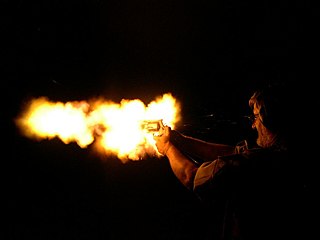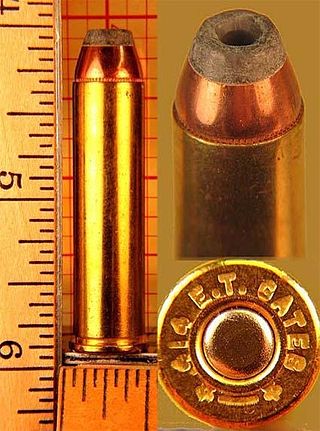
The .38 Special, also commonly known as .38 S&W Special, .38 Smith & Wesson Special, .38 Spl, .38 Spc,, or 9x29mmR is a rimmed, centerfire cartridge designed by Smith & Wesson.

The .357 SIG is a bottlenecked rimless centerfire handgun cartridge developed by the Swiss-German firearms manufacturer SIG Sauer, in cooperation with ammunition manufacturer Federal Premium. The cartridge is used by a number of law enforcement agencies.

The .357 Smith & Wesson Magnum, .357 S&W Magnum, .357 Magnum, or 9×33mmR, is a smokeless powder cartridge with a 0.357 in (9.07 mm) bullet diameter. It was created by Elmer Keith, Phillip B. Sharpe, and Douglas B. Wesson of firearm manufacturers Smith & Wesson and Winchester. The .357 Magnum cartridge is notable for its highly effective terminal ballistics.

The .50 Action Express (AE) (12.7×33mmRB) is a large-caliber handgun cartridge, best known for its usage in the Desert Eagle. Developed in 1988 by American Evan Whildin of Action Arms, the .50 AE is one of the most powerful pistol cartridges in production.

The .44 Remington Magnum, also known as .44 Magnum or 10.9x33mmR, is a rimmed, large-bore cartridge originally designed for revolvers and quickly adopted for carbines and rifles. Despite the ".44" designation, guns chambered for the .44 Magnum round, its parent case, the .44 Special, and its parent case, the .44 Russian all use 0.429 in (10.9 mm) diameter bullets. The .44 Magnum is based on the .44 Special case but lengthened and loaded to higher pressures for greater velocity and energy.
The .357 Maximum, formally known as the .357 Remington Maximum or the .357 Max, is a super magnum handgun cartridge originally developed by Elgin Gates as the wildcat .357 SuperMag. The .357 Maximum was introduced into commercial production as a joint-venture by Remington Arms Company and Ruger in 1983 as a new chambering for the Ruger Blackhawk. Shortly thereafter, Dan Wesson Firearms and Thompson/Center Arms introduced firearms in this cartridge. United Sporting Arms chambered it in their Silhouette series single-action revolvers. It is a .357 Magnum case lengthened 0.300 inches (7.6 mm). Based on the .357 Magnum cartridge, a revolver or single-shot pistol designed for the .357 Remington Maximum will chamber and fire .360 Dan Wesson, .357 Magnum, .38 Special, .38 Long Colt, and .38 Short Colt rounds. Intended primarily as a silhouette cartridge, such high velocity and energy levels have hunting applications. SAAMI pressure level for this cartridge is set at 40,000 pounds per square inch (280 MPa).

The .41 Remington Magnum, also known as .41 Magnum or 10.4×33mmR, is a center fire firearms cartridge primarily developed for use in large-frame revolvers, introduced in 1964 by the Remington Arms Company, intended for hunting and law enforcement purposes.
The .480 Ruger (12.1×33mmR) is a large, high-power revolver cartridge, introduced in 2003 by Ruger and Hornady. It was the first new cartridge introduced by Ruger, and when introduced, was the largest-diameter production revolver cartridge, at .475 in (12.1 mm).

A .50 caliber handgun is a handgun firing a bullet measuring approximately 0.5 inches (12.7 mm) in diameter. Historically, many black powder pistols fired bullets with diameters well above a half inch. However, following the development of smokeless powder, the focus shifted to smaller-diameter bullets propelled at higher velocities, and the development of .50 and larger calibers in handguns became uncommon.

The .460 S&W Magnum round is a powerful revolver cartridge designed for long-range handgun hunting in the Smith & Wesson Model 460 revolver.

The Ruger Blackhawk is a six-shot, single-action revolver manufactured by Sturm, Ruger & Co. It is produced in a variety of finishes, calibers, and barrel lengths.

Elmer Merrifield Keith was an American rancher, firearms enthusiast, and author. Keith was instrumental in the development of the first magnum revolver cartridge, the .357 Magnum (1935), as well as the later .44 Magnum (1956) and .41 Magnum (1964) cartridges, credited by Roy G. Jinks as "the father of big bore handgunning." Keith was born in Hardin, Missouri, and overcame serious injuries that he had sustained at age 12 in a fire when he was living in Missoula, Montana.
The .500 Wyoming Express or .500 WE is a "big bore" handgun cartridge. Freedom Arms introduced the cartridge in 2005 for their Model 83 .500 WE revolver.

The Super Redhawk is a line of double-action magnum revolvers made by Sturm, Ruger beginning in 1987, when Ruger started making weapons using larger, more powerful cartridges such as .44 Magnum, .454 Casull, and .480 Ruger.

Overpressure ammunition, commonly designated as +P or +P+, is small arms ammunition that has been loaded to produce a higher internal pressure when fired than is standard for ammunition of its caliber, but less than the pressures generated by a proof round. This is done typically to produce rounds with a higher muzzle velocity and stopping power, such as ammunition used for security, defensive or hunting purposes. Because of this, +P ammunition is typically found in handgun calibers which might be used for armed security and defensive purposes.

A super magnum is a longer and/or more powerful version of a "magnum" cartridge. Although the term "super magnum" typically refers to a handgun cartridge, created by lengthening an existing straight-case design, it can also refer to rifle and shotgun cartridges, such as the .17 Winchester Super Magnum and the 31⁄2" 12 Gauge Super Magnum. In this case, it simply denotes that it is of greater power than existing "magnums" of similar caliber, similar to other designations such as "Remington Ultra Magnum". The most widespread of these cartridges are the "SuperMag" family of super-magnum handgun cartridges that were proposed and tested by Elgin Gates in the 1970s.

The .327 Federal Magnum is a cartridge introduced by Federal Premium Ammunition and also sold by Sturm, Ruger & Co. It is intended to provide the power of a .357 Magnum in six-shot, compact revolvers, whose cylinders would otherwise only hold five rounds. The .327 has also been used in full-sized revolvers with a capacity of seven rounds or more. The .327 Federal Mag is an example of a "super magnum", because it is a magnum of a magnum, the .32 H&R Magnum.

The .500 Linebaugh is a .50 caliber handgun cartridge designed for use in revolvers. It is considered one of the most powerful handgun cartridges designed in terms of kinetic energy and power factor (momentum).
The .500 S&W Magnum or 12.7×41mmSR is a .50 caliber semi-rimmed revolver cartridge developed by Cor-Bon in partnership with the Smith & Wesson "X-Gun" engineering team for use in the Smith & Wesson Model 500 X-frame revolver and introduced in February 2003 at the SHOT Show. From its inception, it was intended to be the most powerful handgun cartridge to date, with the capacity to harvest all North American game species. While more powerful handgun cartridges, such as the .500 Bushwhacker, have emerged since, they are only available in custom firearms, and the .500 S&W remains the most powerful production handgun cartridge.

The .500 Bushwhacker is a .50 caliber semi-rimmed revolver cartridge developed by TII Armory for the Magnum Research BFR revolvers. It is currently the most powerful revolver cartridge in the world, offering a similar level of ballistic performance to African stopping rifles, such as the .416 Rigby and .470 Nitro Express. Given comparable barrel lengths, it is nearly twice as powerful as the .500 S&W Magnum.















